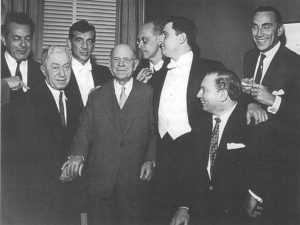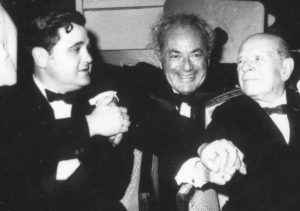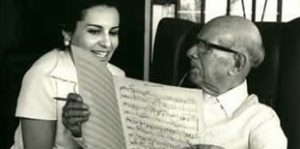Casals and Istomin had not seen each other since July 1955 in Prades. Their correspondence reflected how happy they were to meet and make music together again at the first Puerto Rico Festival in April 1957. They looked forward to sharing two works that they were particularly fond of: Mozart’s Concerto K. 271 and Schubert’s Trio in B flat major. Unfortunately, Casals suffered a heart attack even before the festival began, during a rehearsal of Schubert’s Fifth Symphony. The program was completely disrupted. Alexander Schneider, who had resumed the role of artistic director he had previously played in the first Prades festivals, conducted the orchestra, most often from his concertmaster chair. In 1958, Casals had not yet fully recovered. He was not allowed to conduct and had to be satisfied with playing the cello, including a very moving performance of Beethoven’s Third Sonata with Istomin.
In 1959, Istomin had the honor of opening the festival with a very inspired rendering of Schumann’s Concerto under Schneider. During the following days, there were two memorable trio sessions, in which Istomin and Stern rediscovered the unique pleasure of playing trios with Casals, which had not happened since the 1952 Prades Festival.
Istomin was a member of the Committee of the Puerto Rico Festival from its first inception, but he rarely returned during the 1960s. His schedule was too busy, due to the numerous additional concerts of the Istomin-Stern-Rose Trio. Nevertheless, there was a memorable Brahms program in 1962 along with Casals, with the First Cello Sonata and the Clarinet Trio. Istomin was able to go to Prades and give two concerts in August 1965, playing the Beethoven Variations on a Theme from Judas Maccabeus and Sonata No. 1 with Casals, and accompanying him in El Cant dels Ocells (The Song of the Birds) to close the festival.

Schneider, Horszowski, Bernstein, Casals, Serkin, Istomin, Stern and Piatigorsky at Carnegie Hall. 1958
Istomin regularly visited Casals in Puerto Rico and, occasionally, in Marlboro. Each time Pablo and Marta Casals travelled to New York, he left them his apartment and managed to make their stay as pleasant as possible. If he was not in town, his parents took care of them. In 1958, when Casals returned to New York for the first time in 30 years to participate in the United Nations Concert, Istomin was giving a series of concerts with the New York Philharmonic under Bernstein. All of Casals’ friends had gone to welcome him, and everyone cheerfully gathered at Carnegie Hall to congratulate the performers after the concert, as shown in the incredible adjacent photo!
In 1968, for the 25th anniversary of Istomin’s debut, it was arranged that Istomin would be the soloist for the concert which was traditionally given at Carnegie Hall by the Casals Festival Orchestra after the festival ended. Columbia had planned to record the Beethoven Fourth Concerto. Unfortunately, Casals was so exhausted that he had to give up conducting, and Schneider replaced him. This was a great disappointment for Istomin. The recording was cancelled and finally made a few months later with Eugene Ormandy and the Philadelphia Orchestra.
For the Beethoven’s Bicentennial year in 1970, the Trio Istomin-Stern-Rose stopped in Puerto Rico for two concerts and played the Triple Concerto under Casals’ direction. It was a very special moment. Leonard Rose, who had never before played with Casals, was frequently prone to acute stage fright, especially in this concerto. He was so nervous that he forgot to come in once during the rehearsal – but at the concert it went perfectly. Casals was not sparing with his compliments, and Rose felt very happy! .
Stern and Istomin gave their last concert with Casals the following year, in 1971, at the United Nations. Casals was awarded the Peace Medal and premiered the United Nations Hymn which he had composed to a text by W. H. Auden. He also conducted the Bach Double Concerto BWV 1043 with Schneider and Stern and the Concerto for 3 Pianos in C major BWV 1064 with Istomin, Serkin and Horszowski.
In 1972, mild bronchitis slowed down Casals’ activity at the Puerto Rico Festival. Istomin had suggested that Jean-Bernard Pommier, his former student, be spotlighted. Pommier played one chamber music concert, the Tchaikovsky First Concerto and the Mozart Concerto for Two Pianos together with Istomin who, for his part, took part in only one concert.
The last musical adventure Istomin would share with Casals was the Israel Festival in August 1973, at the time managed by Daniel Barenboim. Casals conducted Mozart’s Symphony No. 33, and Istomin played the Mozart Concerto K. 271 under Schneider in the same concert with the Israel Youth Orchestra. All the musicians had joyously participated in the inauguration of the Jerusalem Music Center in Mishkanot Sha’ananim, which had been magnificently renovated and which became, at the initiative of Isaac Stern and Teddy Kolleck, a major cultural institution. Istomin returned often over the next twenty years to audition young musicians and give master classes. That summer, there were also memorable encounters with two great personalities who had built Israel’s history, Golda Meir and David Ben-Gurion.
A few weeks later, Casals became seriously ill. Istomin came to see him as often as possible. On one of his visits, Casals confided his concern to him about Marta’s future. On October 10, Istomin found Casals seated in a wheelchair, with respiratory assistance. Seeing him so exhausted and in such suffering, Istomin suggested that he listen to music. “Yes”, replied Casals. “Play! Play! I want to live!” Istomin opened the door to the adjoining living room and began to play the Beethoven Waldstein Sonata, one of the works which most intensely expresses the passion to live. Casals soon removed his oxygen mask and despite the stifling heat asked Marta to roll his wheelchair into the living room in order to hear better. He refused to let Marta put on the mask before the sonata was finished, and thanked Istomin with emotion. It was the last music which Casals was really able to hear. Three days later, he had to be rushed to hospital due to a pulmonary embolism.
Istomin came back two days before Casals died. Marta, Casals’ brother Enric, Sasha and a few close friends were the only ones allowed in the room. As Casals appeared restless at times, Istomin suggested playing some music (some Bach and his El Pessebre), which seemed to calm him. He died on October 22, surrounded by the people who loved him the most.
On November 8, just before starting a series of concerts at Carnegie Hall entitled “Stern and Friends”, Istomin delivered a very moving speech at Columbia University’s tribute to Casals. He had chosen to speak of Casals, the man, and he ended with these words: “Good night … Sweet King! You see that you still live by illuminating, by continuing to illuminate all our lives!’’ .
Concerts related to Casals between 1957 and 1973
Puerto Rico 1957
May 1. Mozart. Piano Concerto No. 9 in E flat major K. 271. Casals Festival Orchestra, Alexander Schneider.
May 2. Mozart. Piano Quartet in E flat major K. 493, with Isaac Stern, Milton Katims and Mischa Schneider (in place of the Schubert Trio in B flat with Casals and Stern which was scheduled). Recorded by Columbia.
Puerto Rico 1958
May 7. Beethoven, Cello Sonata No. 3 Op. 69. Pablo Casals. Brahms. Piano Quartet No. 2 Op. 26. Alexander Schneider, Walter Trampler and Mischa Schneider. Recorded concert.
May 8. Brahms, Concerto No. 2. Casals Festival Orchestra, Alexander Schneider. Recorded concert.
Puerto Rico 1959
May 1. Schumann, Concerto. Casals Festival Orchestra, Alexander Schneider. Recorded and filmed concert.
May 2. Mendelssohn, Trio No. 1 in D minor Op. 49. Isaac Stern, Pablo Casals. Recorded concert.
May 6. Brahms, Trio No. 1 in B major Op. 8. Isaac Stern, Pablo Casals. Recorded concert.
Puerto Rico 1962
June 9. Brahms, Cello Sonata No. 1 in E minor Op. 38. Pablo Casals. Trio in A major Op. 114. Robert Marcellus, Pablo Casals. Piano Quartet No. 2 Op. 26. Henryk Szeryng, Milton Thomas and Frank Miller.
Prades 1965
August 8. Schubert, Impromptus Op. 90 No. 3 & 2. Beethoven, Violin Sonatas No. 4 & 5. Irina Botchkova.
August 9. Haydn, Piano Sonata in A. Beethoven, Variations on a Theme from Judas Maccabeus, Piano Sonata No. 21 “Waldstein”, Cello Sonata No. 1 Op. 5 No. 1. Casals, El Cant dels ocells. Pablo Casals.
Puerto Rico 1970
May 31. Beethoven, Concerto No. 3 Op. 37. Casals Festival Orchestra, Alexander Schneider. Triple Concerto Op. 56, Isaac Stern and Leonard Rose, Casals Festival Orchestra, Pablo Casals. Concert recorded and filmed.
June 1. Beethoven, Cello Sonata No. 5 Op. 102 No. 2; Violin Sonata No. 10 Op. 96; Trio in E flat major Op. 70 No. 2. Isaac Stern and Leonard Rose.
United Nations New York 1971
October 24. J.S. Bach. Concerto for 3 Pianos in C major BWV 1064. Rudolf Serkin, Miezyslaw Horszowski, Casals Festival Orchestra, Pablo Casals.
Puerto Rico 1972
June 13. J.S. Bach, Brandenburg Concerto No. 5 BWV 1050. Alexander Schneider (violin and direction) and John Wummer. Mozart, Concerto for 2 Pianos K. 365. Jean-Bernard Pommier. Casals Festival Orchestra, Alexander Schneider.
Israel 1973
August. Beethoven, Trio in E flat major Op. 70 No. 2. Brahms, Trio No. 3 in C minor Op. 101. Mozart, Piano Quartet in G minor K. 478. Isaac Stern, Leonard Rose and Alexander Schneider (viola).
Mozart, Concerto No. 9 in E flat major K. 271. Israel Youth Orchestra, Alexander Schneider.
Documents
Two very moving live recordings.
Brahms. Trio No. 1 in B major Op. 8, first movement. Eugene Istomin, Isaac Stern, Pablo Casals. Concert in San Juan de Puerto Rico on May 6, 1959
.
J.-S. Bach. Concerto for Three Pianos in C major, BWV 1064. Mieczyslaw Horszowski, Eugene Istomin, Rudolf Serkin. Casals Festival Orchestra. Pablo Casals. Concert at the United Nations on October 24, 1971.





